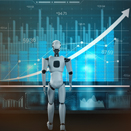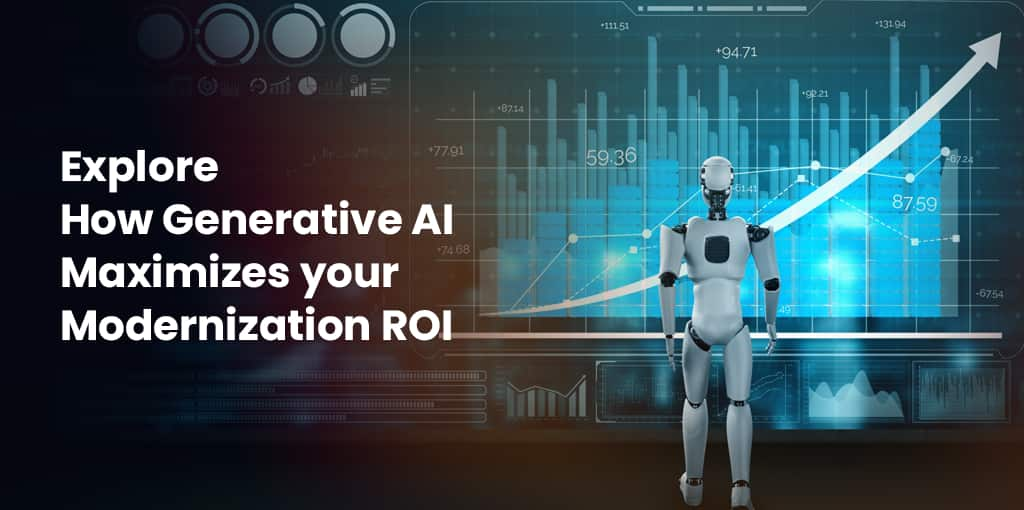
Modernization, or innovation in general, often comes with its own set of challenges, and legacy applications are a prime example of this. These outdated systems significantly hinder market growth and responsiveness, creating bottlenecks that prevent businesses from reaching their full potential. At the same time, modernizing and rearchitecting these legacy systems is an equally complex task that takes thousands of billable hours and resources.
But what if you could transform your application into one with modern frameworks more swiftly and efficiently? How would that reshape the potential and agility of your business operations? This is indeed possible with generative AI. However, with AI, there’s always a follow-up question: Are we fully prepared for it? This blog will explore its vitality in the legacy application modernization space.
Table of Contents
Why Modernize Legacy Systems?
Look at the following graph.
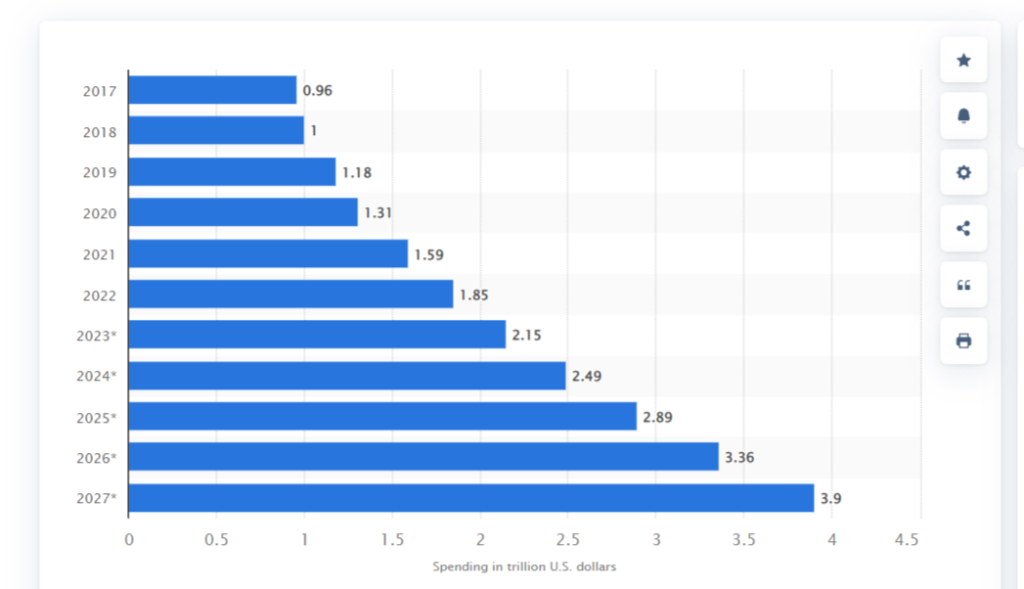
The above graph represents spending on digital transformation technologies and services, including those catering to legacy modernization. The visible increasing pattern underscores the vitality of upgrading to and adopting new technologies for improved business processes, better customer experiences, and innovation.
To learn more about specific challenges and their solutions, check out From Outdated to Optimal: Solving Legacy System Challenges.
Key Factors Driving the Need for Generative AI in Legacy System Modernization
As businesses started modernizing legacy systems after realizing that the systems were a burden, they also came across certain inefficiencies and challenges in the process. Let’s explore some of them.
Affordable and Quick Application Modernization
Generative AI significantly reduces the time and financial commitments required for legacy app modernization. By automating extensive code analysis, rewriting, and system testing, businesses can achieve faster project turnaround times. Such a streamlined approach minimizes disruptions and ensures continuous operation, ultimately leading to a cost-effective modernization process.
Simplified Integration with Modern Technologies
By automatically converting outdated data formats to compatible ones, Generative AI facilitates seamless integration with modern technologies and systems. Additionally, AI-driven updates are less prone to introducing bugs or conflicts, enhancing system stability and reliability. This reduces the scope of potential data loss or corruption.
Enhanced Documentation and Visualization
Generative AI can help with accurate documentation of existing processes and dependencies within legacy systems. It can automatically analyze and map out the structure, providing more clarity & visual insights and allowing developers to understand critical functions. With such accurate and up-to-date documentation, businesses can ensure smoother transitions and more efficient modernization efforts.
As a result, businesses are looking up to gen AI-powered legacy system modernization to automate the process, reduce risks, and improve overall efficiency and productivity.
The Role of Generative AI in Legacy App Modernization
Generative AI turns out to be a great solution to overcome the above roadblocks when modernizing a legacy system.
1. Automated Code Analysis and Refactoring
Generative AI aids in legacy application modernization by automating the analysis of monolithic code. It identifies service boundaries, redundant code, inefficiencies, and potential bugs, helping you outline a code refactoring scope. This knowledge can then create optimized blueprints for microservices-based architecture for greater agility.
2. Upgrading the Architecture
Oftentimes, older applications/systems require extensive changes beyond basic code refactoring or making front-end updates. Generative AI can also help in these areas, allowing you to make substantial changes during legacy app modernization. For instance, it can convert a SOAP service to REST, or REST to gRPC. While it may not entirely generate the upgraded architecture and handle every aspect of the process, it significantly eases the process, allowing developers to make major architectural changes.
3. Helping with API Discovery
Another role that Generative AI plays in transforming legacy application modernization is helping to discover duplicate APIs, especially in complex environments with extensive API portfolios. Large language models, when fine-tuned with various domain rules, can automate documentation analysis, map APIs, and identify redundant & duplicate APIs. This enhanced visibility allows development teams to find and reuse existing APIs rather than creating new ones from scratch, saving time and resources.
4. User Interface (UI) Modernization
When modernizing a legacy application, overlooking user interfaces is a common but significant mistake. A well-optimized UI makes interactions seamless, intuitive, and enjoyable, directly boosting user satisfaction and engagement. Generative AI can be transformative here. Analyzing user interactions can identify common pain points and areas for improvement, suggesting intuitive design elements like simplified menus, clear visual cues, and responsive layouts. This not only enhances the user experience but also ensures your application feels modern and user-friendly.
5. Digital Twin Development for Simulation
Generative AI is extremely helpful in creating digital twins—virtual models of legacy systems/applications. These digital twins allow businesses to run detailed simulations of updates and changes before the actual legacy app modernization process. For instance, you can test new features, identify potential bugs, and evaluate performance improvements in a risk-free environment. This is an excellent way to reduce wasted spending on invalidated feature updates and spot potential modernization vulnerabilities early on in the process.
See How Ford is Using the Digital Twin Technology to Upgrade Autonomous Vehicles
Ford, the world-famous automotive manufacturer, is known for its use of digital twins to enhance the functionality of its software systems used in autonomous vehicles. Using virtual replicas of various physical assets, Ford simulates real-world driving scenarios and observes how the upgraded system responds.
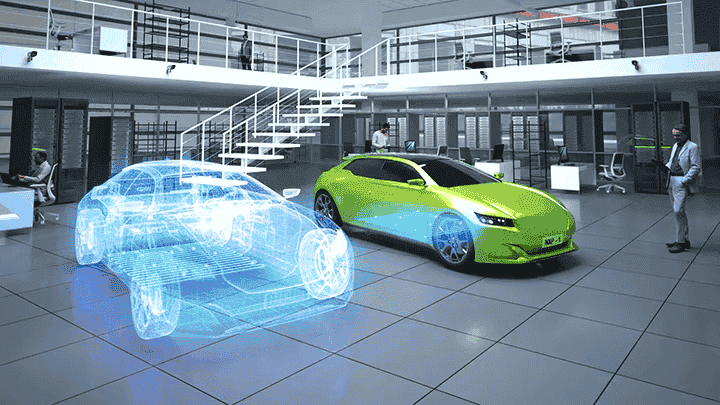
Ethical Considerations: Using Gen AI in Legacy Modernization
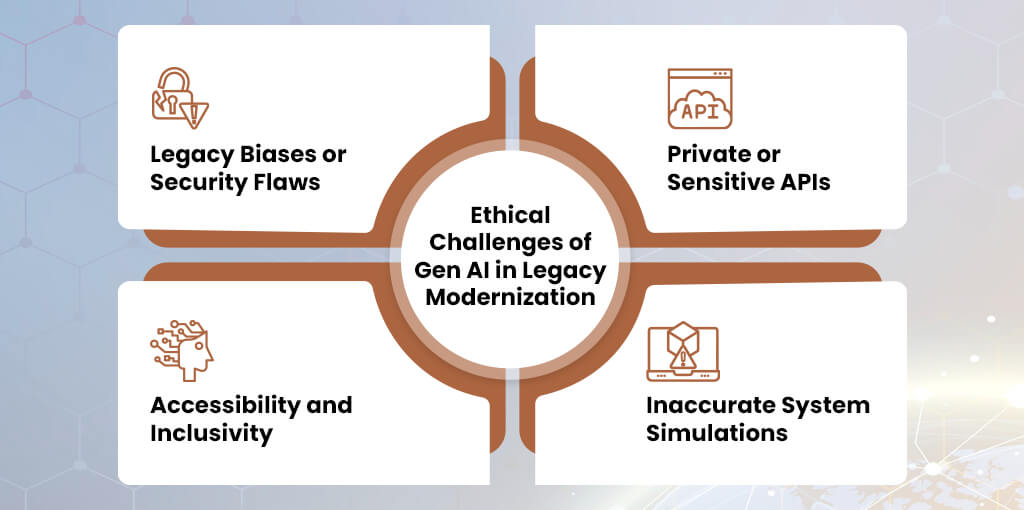
While generative AI accelerates the legacy system modernization process and makes it more efficient; it also presents several ethical considerations.
For instance, it could unintentionally perpetuate legacy biases or security flaws in the original code into the modernized version, carrying forward the inefficiencies. These could be in existing algorithms, data processing pipelines, or security measures.
Additionally, when analyzing API portfolios, it might expose private and sensitive APIs. This may happen if the AI misinterprets the access controls or fails to mask sensitive endpoints during the process.
Moreover, when generative AI is used to modernize UIs, it may apply design changes that exclude certain groups with varying disabilities. To ensure accessibility and inclusivity, you’ll need to address it separately, ensuring the design recommendations align with your goals.
Similarly, when developing a legacy system’s digital twin using outdated data, generative AI simulations may fail to provide accurate representations. For instance, it might fail to account for recent changes or nuances in system behavior, resulting in inaccurate performance predictions and overlooked issues.
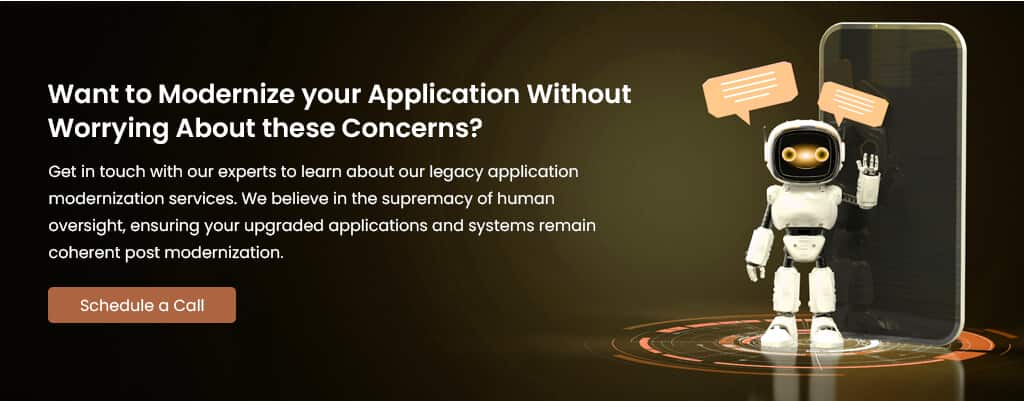
Humans-in-the-Loop Approach
The ethical implications of generative AI in legacy application modernization truly emphasize the need for human oversight. On the one hand, it offers countless capabilities to propel the process. However, on the other, it also comes with a tendency to inadvertently carry forward the inefficiencies of the legacy system and overlook crucial security vulnerabilities.
In this scenario, without expert human oversight, legacy modernization projects risk failing, potentially leading to systems that, while appearing updated, still fall short of current operational standards. This is why, at SunTec India, we follow a humans-in-the-loop approach, ensuring that we modernize your apps using the latest generative AI tools with our human experts validating the process at every step of the way. Our project managers outline the process, developers refine designs and validate the code, and QA professionals ensure the updates meet all security and functionality standards. Contact us at info@suntecindia.com to learn more.

